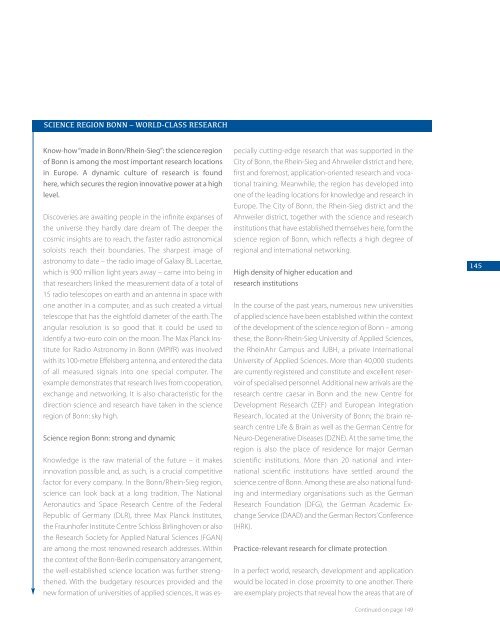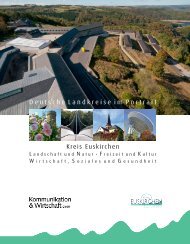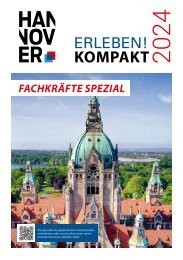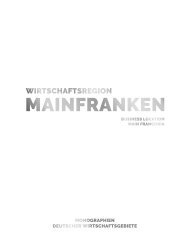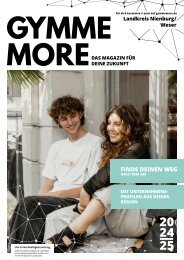Monographie Bonn-Rhein-Sieg
Create successful ePaper yourself
Turn your PDF publications into a flip-book with our unique Google optimized e-Paper software.
SCIENCE REGION BONN – WORLD-CLASS RESEARCH<br />
Know-how “made in <strong>Bonn</strong>/Rhein-<strong>Sieg</strong>”: the science region<br />
of <strong>Bonn</strong> is among the most important research locations<br />
in Europe. A dynamic culture of research is found<br />
here, which secures the region innovative power at a high<br />
level.<br />
Discoveries are awaiting people in the infinite expanses of<br />
the universe they hardly dare dream of. The deeper the<br />
cosmic insights are to reach, the faster radio astronomical<br />
soloists reach their boundaries. The sharpest image of<br />
astronomy to date – the radio image of Galaxy BL Lacertae,<br />
which is 900 million light years away – came into being in<br />
that researchers linked the measurement data of a total of<br />
15 radio telescopes on earth and an antenna in space with<br />
one another in a computer, and as such created a virtual<br />
telescope that has the eightfold diameter of the earth. The<br />
angular resolution is so good that it could be used to<br />
identify a two-euro coin on the moon. The Max Planck Ins -<br />
titute for Radio Astronomy in <strong>Bonn</strong> (MPIfR) was involved<br />
with its 100-metre Effelsberg antenna, and entered the data<br />
of all measured signals into one special computer. The<br />
example demonstrates that research lives from cooperation,<br />
exchange and networking. It is also characteristic for the<br />
direction science and research have taken in the science<br />
region of <strong>Bonn</strong>: sky high.<br />
Science region <strong>Bonn</strong>: strong and dynamic<br />
Knowledge is the raw material of the future – it makes<br />
innovation possible and, as such, is a crucial competitive<br />
factor for every company. In the <strong>Bonn</strong>/Rhein-<strong>Sieg</strong> region,<br />
science can look back at a long tradition. The National<br />
Aeronautics and Space Research Centre of the Federal<br />
Republic of Germany (DLR), three Max Planck Institutes,<br />
the Fraunhofer Institute Centre Schloss Birlinghoven or also<br />
the Research Society for Applied Natural Sciences (FGAN)<br />
are among the most renowned research addresses. Within<br />
the context of the <strong>Bonn</strong>-Berlin compensatory arrangement,<br />
the well-established science location was further streng -<br />
thened. With the budgetary resources provided and the<br />
new formation of universities of applied sciences, it was especially<br />
cutting-edge research that was supported in the<br />
City of <strong>Bonn</strong>, the Rhein-<strong>Sieg</strong> and Ahrweiler district and here,<br />
first and foremost, application-oriented research and vocational<br />
training. Meanwhile, the region has developed into<br />
one of the leading locations for knowledge and research in<br />
Europe. The City of <strong>Bonn</strong>, the Rhein-<strong>Sieg</strong> district and the<br />
Ahrweiler district, together with the science and research<br />
institutions that have established themselves here, form the<br />
science region of <strong>Bonn</strong>, which reflects a high degree of<br />
regional and international networking.<br />
High density of higher education and<br />
research institutions<br />
In the course of the past years, numerous new universities<br />
of applied science have been established within the context<br />
of the development of the science region of <strong>Bonn</strong> – among<br />
these, the <strong>Bonn</strong>-Rhein-<strong>Sieg</strong> University of Applied Sciences,<br />
the RheinAhr Campus and IUBH, a private International<br />
University of Applied Sciences. More than 40,000 students<br />
are currently registered and constitute and excellent reservoir<br />
of specialised personnel. Additional new arrivals are the<br />
research centre caesar in <strong>Bonn</strong> and the new Centre for<br />
Development Research (ZEF) and European Integration<br />
Research, located at the University of <strong>Bonn</strong>; the brain research<br />
centre Life & Brain as well as the German Centre for<br />
Neuro-Degenerative Diseases (DZNE). At the same time, the<br />
region is also the place of residence for major German<br />
scientific institutions. More than 20 national and inter -<br />
national scientific institutions have settled around the<br />
science centre of <strong>Bonn</strong>. Among these are also national funding<br />
and intermediary organisations such as the German<br />
Research Foundation (DFG), the German Academic Exchange<br />
Service (DAAD) and the German Rectors’ Conference<br />
(HRK).<br />
Practice-relevant research for climate protection<br />
In a perfect world, research, development and application<br />
would be located in close proximity to one another. There<br />
are exemplary projects that reveal how the areas that are of<br />
Continued on page 149<br />
145


